
We know its not a bird, but it is July, so you are rather unlikely to see
a decent bird this month. We'll be more than happy to be proved wrong though!
And we were. For pictures of the Rose-coloured Starling just scroll down!!
ACKNOWLEDGEMENTS:
Thanks to all of
the following who have contributed to this page during 2001:
Peter Allard, Chris & Alison
Allen, Chris Baker, Leslie Batchelder, Derek Beamish, Kevin Blowers, James
Brown, Tim Brown, Jon Burrell, Roger Conner, Matthew Deanes, Andrew Easton,
Mark Ellis, Ricky Fairhead, Jenny Gort, John Grant, Lee Gregory, Dave Holman,
Robert Holmes, Mike Marsh, Don & Gwen Moore, Rob Murray, Chris Mutimer,
Peter Napthine, Peter Ransome, Jim Read, Neville Skinner, Brian Small, Richard
Smith, Simon de Tute, David Walsh, Jon Warnes, Steve & Jane Whiteside,
Robert Wilton, Robert Wincup, James Wright, Peter Wright, Jack Wylson &
anyone we have inadvertently missed.
| Year 2000 Review | Year 2001 Review - so far | Current News |
Please
feel free to e-mail any sightings from the Lowestoft area to us at
loungedweller@hotmail.com
WEEK ENDED AUGUST 05, 2001
Completely
out of the blue came the pink this week. A stunning Rose-coloured Starling
was certainly a surprise. It was seen on July 30th and 31st in the Carlton
Colville area and not since but is almost certainly still in the area.
Arctic Skua Stercorarius parasiticus
Three flew south past Ness
Point in a short seawatch late afternoon on the 31st.
Mediterranean Gull Larus melanocephalus
One adult was feeding on the
south beach and South Pier, Lowestoft on the evening of the 30th.
Arctic Tern Sterna
paradisaea
A juvenile was seen at Ness Point
on the 2nd.
Sedge Warbler Acrocephalus schoenobaenus
An adult is present in a fridge in Sharon Drive, north Lowestoft after fatally
flying into a house window on August 1st. This is a little way from any
typical breeding habitat, so it seems the autumn migration is now under
way.
| Rose-coloured Starling Sturnus roseus |
 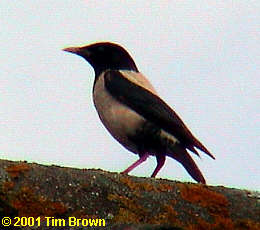 |
|
A rather smart individual was noticed by a resident
of Carlton Colville on the 30th, it spent a large part of the day
around the Tudor Walk and Elmdale Drive area, although it did disappear
for long periods of time and wasn't seen after 4pm BST. Apparently
it had been seen in neighbouring gardens the day before. |
|
Although the three Ruddy Shelduck, Tadorna ferruginea, recently present at Benacre Broad have departed, apparently for Oxfordshire, we thought the fact there were 101 present in The Netherlands during the week might be of interest. Granted the country does have a feral population but according to Euro Birdnet this number is around 15 pairs. Not that we are speculating but where did the others come from? Are there any other feral populations around? |
Other
Wildlife
Red-eyed Damselflies Erythromma
najas are again present at Kirkley Fen this year, with up to 14 being
noted recently. These are slightly closer to home than those at Lound Waterworks
which is the main site for this species locally. A few Holly Blue
butterflies, Celastrina argiolus, were noted in the Tudor Walk area
on the 31st.
WEEK ENDED JULY 29, 2001
|
The
Lockheed F117A Nighthawk stealth fighter was the highlight for
many on the first day of the fifth Lowestoft Seafront Air Festival,
its early arrival caught most of the estimated 160,000 crowd by surprise.
|
Black-tailed
Godwit Limosa limosa
109 were counted on the south
shore of Breydon Water at low tide on the 28th. The total number present
on the estuary was 1,001 most were stunning adults. Other waders
present included 22 Avocet, Recurvirostra
avosetta, Golden
Plover, Pluvialis apricaria, 3 Ruff Philomachus pugnax,
as well as the more expected species, Ringed Plover, Charadrius
hiaticula, Eurasian
Curlew, Numenius arquata, Common Redshank, Tringa totanus,
Whimbrel,
Numenius phaeopus, Dunlin, Calidris alpina and
Turnstone, Arenaria interpres.
Common
Sandpiper Actitis hypoleucos
Two flew north past Ness Point
on the 28th.
Pomarine Skua Stercorarius pomarinus
One adult flew south past Ness
Point at 16:26 on the 25th.
Mediterranean Gull Larus melanocephalus
One adult was seen at the
north beach Lowestoft on the 24th and 25th, below is a photo of one of at
least two birds present at the moment. An adult seen on Lowestoft South
Beach had a foot missing and is presumably the same individual present at
the Ness Point sewage outfall during the winter and not the bird pictured
below! An adult was at Ness Point the following day.
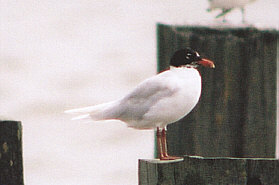
Little
Gull L. minutus
Six were along the
north beach at Lowestoft on the 25th.
14 were between Ness
Point and Gunton on the 28th.
Yellow-legged Gull L. michahellis
One adult was again on the
groynes along the north beach at Lowestoft on the 24th.
Kingfisher Alcedo
atthis
A pair were present at Fritton Lake during the week and another was seen
at Carlton Marshes on the 29th.
Other
Wildlife
At least
one of the regular Harbour Porpoises, Phocoena phocoena, was
off Ness Point and the north beach on the 24th, with two there on the 25th.
Single Common Phoca
vitulina and
Grey Seals Halichoerus
grypus were
again off the north beach Lowestoft on the 25th. Several butterflies were
along Breydon South Wall on the 28th including Gatekeeper, Pyronia
tithonus, Ringlet, Aphantopus hyperantus, and Wall
Brown, Lasiommata megera. A single White Admiral, Ladoga
camilla, was present at Fritton Lake during the week one of only a handful
reported locally this year.
WEEK ENDED JULY 22, 2001
On
the morning of the 21st a small passage of seabirds was still evident with
the highlight being another southbound Storm Petrel for the week
at 9:39. Most previous records of this species have been in September, probably
due to the usual lack of suitable seawatching weather (i.e. bad) in most
summers. Other birds noted between 9: and 10:30 were 23 Northern Gannets
all but two northbound, Common Scoter 12 north, Oystercatcher
six south, Redshank four south, Arctic Skua three north, Sand
Martin one south. There were also numerous Kittiwakes, Little
Gulls, Common and Sandwich Terns passing south and resting
on the groynes along the north beach. In the afternoon not much passage
was evident but a a flock of seven Whimbrel headed south.
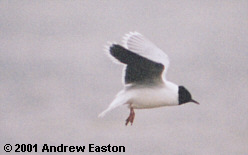

Seen above are photos of just
two of the many Little Gulls currently being seen offshore and resting
on the groynes at Lowestoft. The one on the left is a full summer plumaged
adult and the one on the right is a moulting first summer bird. Many of
the adults still have a pink suffusion on the underparts.
The
19th proved far quieter than the day before, with just three Manx Shearwaters
and six Arctic Skuas north in the morning, but the highlight was
the appearance of a Puffin Fratercula arctica quite close
inshore flying south, there were also two rather distant unidentified Auks
as well.
Also seen that morning were two Fulmars, three Northern Gannets,
three Wigeon Anas penelope, a Whimbrel, three Bar-tailed
Godwits and 16 Little Gulls. Two small waders, possibly Turnstones,
settled on a passing ship, briefly ran around the deck and then took off
and continued their northward journey. In the evening between 19:00 and
19:20 six Arctic Skuas, ten Gannets and a Whimbrel
flew south.
After a few good seabirds being seen moving past Ness Point early in the
week the 18th between 4:30 and 20:30 BST proved to be outstanding, with
highlights as follows:
Storm Petrel Hydrobates pelagicus one south at 7:40.
Manx Shearwater Puffinus puffinus 59 south, 2 north.
Northern Gannet Morus
bassanus 357 mostly south.
Kittiwake Rissa tridactyla c.1800 south, but 200 back north
in last 2 hours.
Arctic Skua Stercorarius parasiticus 15 south.
Great Skua S. skua one south.
Little Gull Larus minutus 15 south.
Common Tern Sterna hirundo 56 south.
Little Tern S. albifrons 14 south.
Sandwich Tern S. sandvichensis 7 south.
Arctic Tern S. paradisaea one south.
Black Tern Chlidonias niger 2 adults south.
Rather surprisingly there were only eight Northern Fulmars Fulmarus
glacialis seen!
Waterfowl included
Dark-bellied Brent Goose Branta
bernicla one south; Shelduck
Tadorna
tadorna one south; Teal
Anas
crecca 6 south;
Tufted Duck Aythya
fuligula
8
south;
Eider Somateria
mollissima 3 males south;
Common Scoter Melanitta
nigra 357
south.
Waders noted were Oystercatcher Haematopus ostralegus 2 south;
Knot Calidris canutus 2 south; Dunlin C. alpina
7 south; Curlew Numenius arquata 26 south; Whimbrel
N. phaeopus 11 south; Bar-tailed Godwit Limosa lapponicus
6 south; Redshank Tringa totanus 5 south; Green Sandpiper
T. ochropus one south; Common Sandpiper Actitis hypoleucos
one south; Grey Plover Pluvialis squatarola one south; Golden
Plover P. apricaria one south; Turnstone Arenaria interpres
one south.
Fulmar
Fulmarus glacialis
Small numbers
were flying north at Ness Point on the 17th.
Sooty
Shearwater Puffinus
griseus
Two flew north past Ness Point
on the afternoon of the 17th.
Northern Gannet Morus
bassanus
Five flew
north at Ness Point on the afternoon of the 17th.
Little
Egret
Egretta garzetta
One
flew in off the sea at Ness Point at 17:55 on the 22nd.
Common
Scoter Melanitta
nigra
40 flew north and 20 south at Ness Point on the 17th.
Avocet Recurvirostra
avosetta
Six
on the mudflats at Burgh Castle on the 19th. On the 22nd six were again
at Burgh Castle and several more were feeding on the nearby South Flats,
Breydon.
Knot Calidris
canutus
Four were on the South Flats at
Breydon Water on the 22nd.
Curlew
Sandpiper
C. ferruginea
Three adults were on the South
Flats at Breydon Water on the 22nd.
Up to 15 adults were roosting near the hide on the north
side that morning.
Ruff Philomachus
pugnax
Seven
on the mudflats at Burgh Castle on the 19th. On the 22nd there were four
on the South Flats, Breydon Water and seven again on Burgh Castle mudflats.
Good numbers of Black-tailed Godwit Limosa limosa and Whimbrel
were also feeding on the South Flats on the 22nd.
Curlew
Numenius
arquata
One
flew south past Ness Point on the 17th.
Turnstone
Arenaria interpres
One flew south at Ness Point
on the 21st and four were on the rocks there on the 22nd before flying south.
Mediterranean
Gull Larus melanocephalus
One adult flew north at Ness
Point on the 17th and 18th. Two were along the north beach on the 22nd.
Little
Gull L. minutus
At least ten, mostly adults
flew north at Ness Point the afternoon of the 17th.
Large numbers of Kittiwakes
Rissa tridactyla and several Common Sterna hirundo
and Sandwich Terns S. sandvichensis were also passing north
there on the same date.
Yellow-legged
Gull L. michahellis
One adult, apparently the
same individual that has been returning in late summer for at least four
years was noted along the north beach on the 19th and 22nd.
Starling
Sturnus vulgaris
One partially leucistic juvenile
was feeding with a flock along the south shore of Breydon Water on the 22nd.
The head and underparts appeared normal but the wings, tail and mantle were
a very pale creamy brown in colour, with the outer primaries being almost
white..
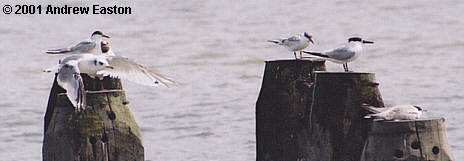
At left
is a picture taken at Lowestoft north beach on the 21st, when many of the
groynes were occupied by large numbers of gulls and terns. In this picture
can be seen Sandwich Tern (juvenile back right and adult centre right),
first summer Kittiwake (front left in flight), Black-headed Gull
(centre left behind Kittiwake) and Common Terns (adult back left
and juvenile front right).
Other
Wildlife
A bull
Grey Seal Halichoerus grypus was lingering offshore along the
north beach Lowestoft on the 21st and a single Harbour Porpoise,
Phocoena phocoena, was off Ness Point on the same morning. A Common
Seal Phoca vitulina was off Ness Point on the 22nd.
WEEK ENDED JULY 15, 2001
Fulmar
Fulmarus glacialis
Small numbers
were feeding at the sewage outfall at Ness Point on the 14th.
Northern
Gannet Morus
bassanus
Small numbers
were passing offshore at Ness Point on the 14th & 15th.
Little
Egret
Egretta garzetta
One flew south close inshore past Ness Point on the 11th.
Still a quite a rarity in north Suffolk.
Common
Scoter Melanitta
nigra
30 flew north at Ness Point on the 14th, and three were drifting
south on the sea there on the 15th.
Curlew
Numenius
arquata
One
flew south past Ness Point on the 15th.
Greenshank Tringa
nebularia
One flew over calling
at Haddiscoe Bridge early evening on the 9th.
Turnstone
Arenaria interpres
One was at Ness Point on the
14th.
Arctic Skua Stercorarius parasiticus
At least four, two light phase
together and at least two dark phase, were lingering offshore at Ness Point
on the 15th. In between attacks on gulls they would settle on the sea and
drift south with the tide.
Mediterranean Gull Larus melanocephalus
One adult was feeding at the
sewage outfall at Ness Point on the 14th, and it or another was in flight
over the North Denes on the 15th.
Little
Gull L. minutus
One adult and a first summer
were feeding at the sewage outfall at Ness Point on the 14th. At least ten,
mostly adults were drifting past on the sea there on the 15th.
Herring
Gull L.
argentatus
|
|
Siskin
Carduelis spinus
One flew west over Sussex
Road, Lowestoft on the morning of the 15th.
Common Crossbill Loxia curvirostra
One was seen and heard in flight
at Lound on the 13th. Hopefully we will get a rerun of the 1990 summer irruption.
Parakeet species
Two unidentified parakeets were seen at Oulton village on the 13th, with
another at nearby Fir Lane, Lowestoft the same evening.
Other Wildlife
A Lunar Hornet Moth Sesia
bembeciformis was noted at Carlton Colville on the 9th, and a
Hummingbird Hawkmoth Macroglossum stellatarum was seen at
Mutford on the 13th.
An earlier example was seen at Haddiscoe on June 27th. A
Grey Seal Halichoerus grypus and two Harbour Porpoises,
Phocoena phocoena, were seen at Ness Point on the 14th. There were
at least three Porpoises there on the 15th. A Horntail or Wood
Wasp Urocerus gigas was seen at Ness Point on the 15th, not surprisingly
it didn't hang around as there aren't too many trees to lay eggs in around
there!
WEEK ENDED JULY 08, 2001
Fulmar
Fulmarus glacialis
Small numbers
were feeding at the sewage outfall at Ness Point on the 8th.
Northern
Gannet Morus
bassanus
11 flew north
past Ness Point on the 8th.
Grey
Heron Ardea
cinerea
Two flew west over central
Lowestoft and headed out to sea on the 6th.
Quail
Coturnix coturnix
One was reported on the
pager services as calling near Blundeston Prison on the evening of the 5th.
None have been heard at Gisleham this year so far.
Avocet
Recurvirostra avosetta
Two on the mudflats at Burgh
Castle on the 8th.
Ringed
Plover Charadrius hiaticula
One was feeding at Ness
Point on the 6th.
Ruff
Philomachus pugnax
Five on the mudflats at Burgh
Castle on the 8th.
Eurasian
Curlew Numenius arquata
Four flew
south past Ness Point on the 8th.
Common
Redshank Tringa totanus
One flew south
past Ness Point on the 8th.
Greenshank
Tringa nebularia
One flew south calling
over central Lowestoft during the afternoon of the 7th.
Common
Sandpiper Actitis hypoleucos
One was watched walking up
the driveway of the observers house in Sharon Drive, central Lowestoft on
the 7th. It seems a few waders were caught up in the heavy rain around at
the time.
Arctic Skua Stercorarius parasiticus
One pale phase
bird was chasing gulls for a short time at the sewage outfall at Ness Point
on the 8th.
Mediterranean
Gull Larus melanocephalus
One adult was feeding at the
sewage outfall at Ness Point on the 8th.
Little
Gull L. minutus
One adult was feeding at the
sewage outfall at Ness Point on the 8th.
Common
Tern Sterna hirundo
The nesting colony along
Lake Lothing has at least 24 adults present, so a minimum of twelve pairs
seems reasonable, and seven broods totalling 14 young could be seen on the
visible sides of the sloping roofs on the 8th. At least one of these young
was already making short flights.
Little
Owl Athene
noctua
One at Gisleham on the 6th.
Skylark
Alauda arvensis
A deafening chorus at dusk at Gisleham on the 6th. Their numbers seem to
be holding up well here at least, and as a result it was hard to hear the
Corn Bunting because of the Skylarks drowning it out!.
Yellow Wagtail
Motacilla flava
One at Gisleham on the 6th, apparently nesting in the crops.
Willow
Tit Parus
montanus
One was seen at Haddiscoe on the 8th, so they are not quite extinct
in this area of the Waveney Valley.
Corn Bunting
Miliaria calandra
One singing well in crops at Gisleham on the 6th.
Other
Wildlife
At
least two, possibly three, Harbour Porpoises, Phocoena phocoena,
were feeding close inshore off Ness Point on the 8th. Large numbers of Summer
Chafers (July Bugs)Amphimallon solstitialis
were making observation difficult at Gisleham on the 6th by persistently
and noisily harassing the observers.
WEEK ENDED JULY 01, 2001
Hobby
Falco
subbuteo
Single
birds were seen at Carlton Marshes, and North Cove Marshes on the 25th.
One at St Olaves on the 30th was terrorizing the local House Martins
Delichon urbica. Whilst one at Carlton Marshes the same day was doing
its best to thin out the Norfolk Hawker Aeshna isoceles population.
Lesser
Black-backed Gull Larus
fuscus
Despite ample room on numerous
flat roofs in Lowestoft at least three pairs are now nesting on top of residential
chimneys.
Common
Swift Apus apus
500 south past Corton on the evening
of the 27th were part of a feeding flock navigating around thunderstorms.
Such groups will travel large distances to avoid adverse weather systems.
Common Crossbill Loxia curvirostra
Seven were reported near the Hopton
Timber Mills at Lound on the 30th. Probably
immigrants from the continent as there have been none reported in the area
early in the year.
| Year 2000 Review | Year 2001 Review - so far | Current News |
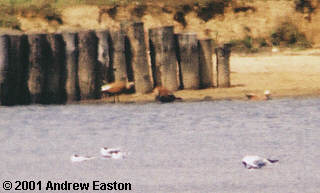

 One
pair was confirmed as nesting amongst chimney pots on residential
buildings along Denmark Road, central Lowestoft. The adults had been
swooping down aggressively at passing pedestrians recently so breeding
was suspected, but no young were seen until the 9th. They have
been nesting on house roofs in nearby Commercial Road for a few years
now but this is the first chimney nesting in
Lowestoft by this species as
far as is known.
One
pair was confirmed as nesting amongst chimney pots on residential
buildings along Denmark Road, central Lowestoft. The adults had been
swooping down aggressively at passing pedestrians recently so breeding
was suspected, but no young were seen until the 9th. They have
been nesting on house roofs in nearby Commercial Road for a few years
now but this is the first chimney nesting in
Lowestoft by this species as
far as is known.